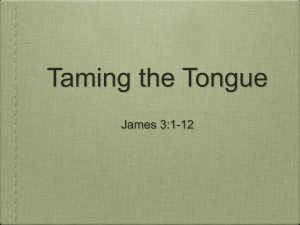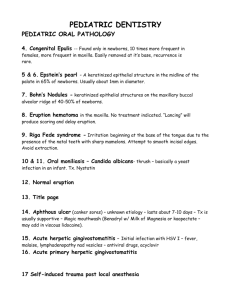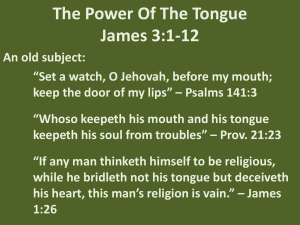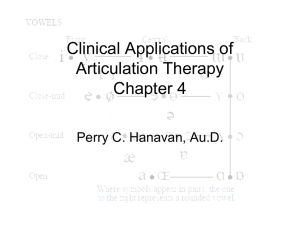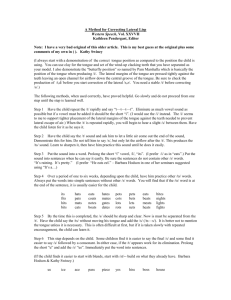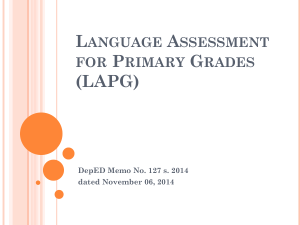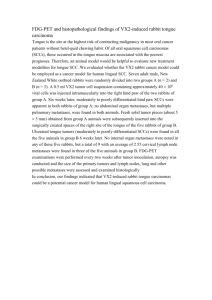Soft Tissue Dysfunction: a Missing Clue when
advertisement
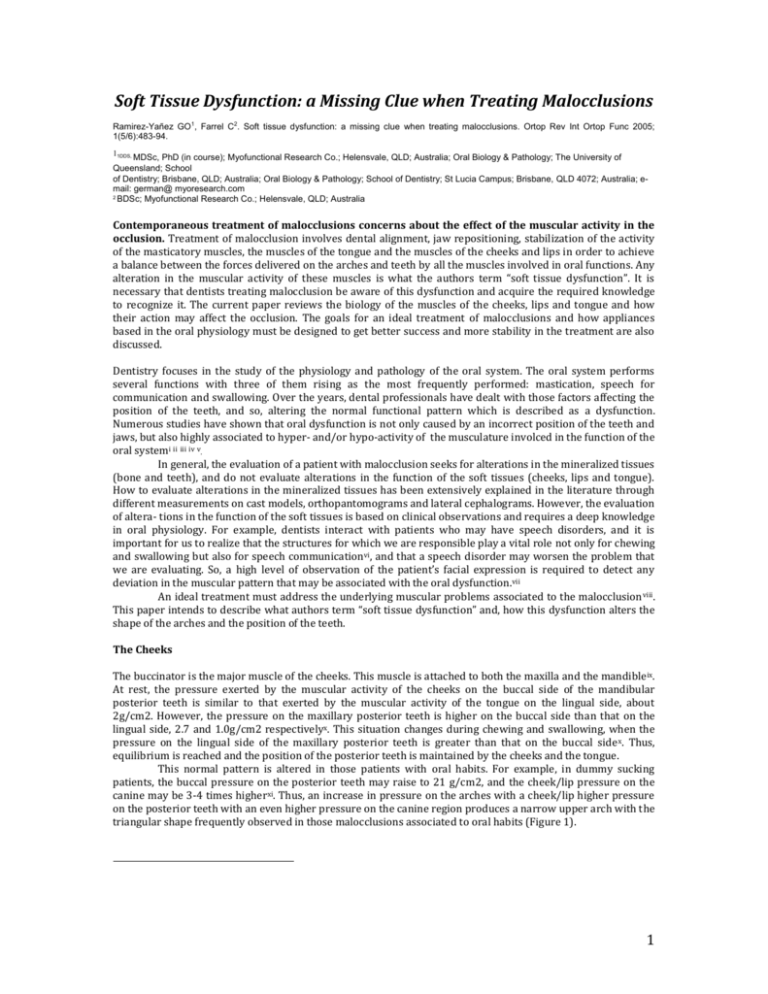
Soft Tissue Dysfunction: a Missing Clue when Treating Malocclusions Ramirez-Yañez GO1, Farrel C2. Soft tissue dysfunction: a missing clue when treating malocclusions. Ortop Rev Int Ortop Func 2005; 1(5/6):483-94. 11DDS, MDSc, PhD (in course); Myofunctional Research Co.; Helensvale, QLD; Australia; Oral Biology & Pathology; The University of Queensland; School of Dentistry; Brisbane, QLD; Australia; Oral Biology & Pathology; School of Dentistry; St Lucia Campus; Brisbane, QLD 4072; Australia; email: german@ myoresearch.com 2 BDSc; Myofunctional Research Co.; Helensvale, QLD; Australia Contemporaneous treatment of malocclusions concerns about the effect of the muscular activity in the occlusion. Treatment of malocclusion involves dental alignment, jaw repositioning, stabilization of the activity of the masticatory muscles, the muscles of the tongue and the muscles of the cheeks and lips in order to achieve a balance between the forces delivered on the arches and teeth by all the muscles involved in oral functions. Any alteration in the muscular activity of these muscles is what the authors term “soft tissue dysfunction”. It is necessary that dentists treating malocclusion be aware of this dysfunction and acquire the required knowledge to recognize it. The current paper reviews the biology of the muscles of the cheeks, lips and tongue and how their action may affect the occlusion. The goals for an ideal treatment of malocclusions and how appliances based in the oral physiology must be designed to get better success and more stability in the treatment are also discussed. Dentistry focuses in the study of the physiology and pathology of the oral system. The oral system performs several functions with three of them rising as the most frequently performed: mastication, speech for communication and swallowing. Over the years, dental professionals have dealt with those factors affecting the position of the teeth, and so, altering the normal functional pattern which is described as a dysfunction. Numerous studies have shown that oral dysfunction is not only caused by an incorrect position of the teeth and jaws, but also highly associated to hyper- and/or hypo-activity of the musculature involced in the function of the oral systemi ii iii iv v. In general, the evaluation of a patient with malocclusion seeks for alterations in the mineralized tissues (bone and teeth), and do not evaluate alterations in the function of the soft tissues (cheeks, lips and tongue). How to evaluate alterations in the mineralized tissues has been extensively explained in the literature through different measurements on cast models, orthopantomograms and lateral cephalograms. However, the evaluation of altera- tions in the function of the soft tissues is based on clinical observations and requires a deep knowledge in oral physiology. For example, dentists interact with patients who may have speech disorders, and it is important for us to realize that the structures for which we are responsible play a vital role not only for chewing and swallowing but also for speech communicationvi, and that a speech disorder may worsen the problem that we are evaluating. So, a high level of observation of the patient’s facial expression is required to detect any deviation in the muscular pattern that may be associated with the oral dysfunction.vii An ideal treatment must address the underlying muscular problems associated to the malocclusion viii. This paper intends to describe what authors term “soft tissue dysfunction” and, how this dysfunction alters the shape of the arches and the position of the teeth. The Cheeks The buccinator is the major muscle of the cheeks. This muscle is attached to both the maxilla and the mandible ix. At rest, the pressure exerted by the muscular activity of the cheeks on the buccal side of the mandibular posterior teeth is similar to that exerted by the muscular activity of the tongue on the lingual side, about 2g/cm2. However, the pressure on the maxillary posterior teeth is higher on the buccal side than that on the lingual side, 2.7 and 1.0g/cm2 respectivelyx. This situation changes during chewing and swallowing, when the pressure on the lingual side of the maxillary posterior teeth is greater than that on the buccal side x. Thus, equilibrium is reached and the position of the posterior teeth is maintained by the cheeks and the tongue. This normal pattern is altered in those patients with oral habits. For example, in dummy sucking patients, the buccal pressure on the posterior teeth may raise to 21 g/cm2, and the cheek/lip pressure on the canine may be 3-4 times higherxi. Thus, an increase in pressure on the arches with a cheek/lip higher pressure on the posterior teeth with an even higher pressure on the canine region produces a narrow upper arch with the triangular shape frequently observed in those malocclusions associated to oral habits (Figure 1). 1 FIGURE 1: Fifteen years old girl with a soft tissue dysfunction associated to malocclusion. Note narrowness and the triangular shape of the upper arch (B) due to hyperactivity of the buccinator muscles delivering high forces on the posterior teeth with even higher forces on the canine area. Incompetence for lip sealing collaborates to the triangular shape and crowded teeth (C) as the force that should be delivered by the upper lip on the incisors is not present in this patient. The Lips The upper and lower orbicularis oris are the main structure of the lips. Their mutual activity permits a lip seal, which closes the entrance of the oral cavity. At rest with a lip seal, the mentalis activity is negligible in the patients with normal occlusion v. Therefore, lip seal must show muscular activity of the orbicularis oris, but should show no activity in the mentalis. The force produced by the orbicularis oris is light and continuous, and has been estimated by means of the force transmitted to lip bumpers. It has been calculated 12-14 g at rest and 33-36 g over swallowingxii. The force of the tongue on the lingual surface of the incisors has been calculated as 0.8-1.6 g/cm2 at restxiii xiv. However, this force may increase to 3-7 g/cm2 in oral breathing patientsxv. Studies have shown that the orbicularis oris may exert a force on a lip bumper up to 300 g and the tongue may exert forces up to 500gxvi xvii. Some authors have suggested that the tongue pressure on the incisors is greater than forces produced by the lip musculature xviii xix xx. A recent study has shown that at rest, the pres- sure exerted by the lips directly on the upper and lower incisors is very low, even negative pressurev xxiii. Thus, equilibrium is reached and a correct position of the incisors is maintained because a higher but non-continuous force is delivered by the tongue on the lingual surface of the incisors, whereas a lower but continuous force is delivered by the lips on the buccal surface of the anterior teeth xxi xxii. In the incompetent lip patient, lip contact produces greater muscular activity of the orbicularis oris, whereas at rest with the lips separated, there is no activity in the upper or in the lower orbicularis oris v. In addition, mentalis muscular activity increases to moderate during saliva deglutition, and it is greater during water deglutition. Conversely, the orbicularis oris present slight to moderate activity during saliva and water deglutition in incompetent lip patientsxxiii. Nevertheless, as the most of the time the lips remain separated in the incompetent lip patient, no muscular activity of the orbicularis oris is the most frequent situation in these patients. Thus, the equilibrium between the tongue/lip muscular activities is lost and the pressure of the tongue moves the incisor buccal-ward. In addition, during swallowing, which occurs between 600 and 2400 times each dayxxiv, the lip incompetent patient produces compression on the anterior part of the mandible, which results in that convex profile frequently observed in patients with lip incompetence due to an undeveloped chin (Figure 2). FIGURE 2: Eleven years girl with soft tissue dysfunction associated to disto-occlusion (B). This malocclusion results from hyperactivity of the mentalis which produces a backward force on the anterior area of the mandible, and so, opposites to normal mandibular growth (C). The Tongue The tongue is a structurally complex and extremely flexible organ occupying a large portion of the oral cavity. The tongue resting position refers to a reproducible physiologically relaxed position of the organ observed when the lips are smoothly sealed, or slightly separated, and the mandible is slightly openedxxv. At this position, the tongue produces the lowest pressure on the surrounding structures, whereas during its movements to participate in the oral functions, the pressure increases or reduces at different sites at different timesx. The most performed activity of the tongue is that observed during swallowing. This oral function is divided into six stagesxxvi, starting from a resting position where the tip of the tongue is positioned behind the lingual surface of the upper incisors, slightly touching the anterior palate, the dorsum running parallel and near to the hard palate and the posterior part of the tongue mostly in contact with the soft palate. At the second stage, the tip of the tongue locates at its most backward position. Stage three is characterized by the fixation of the 2 tongue tip on the anterior palate and a descending of the dorsum of the tongue. At stage four, the soft palate rises to the highest level with the dorsal surface of the tongue mostly in contact with the palate. At stage five, the soft palate descends to the lowest position, and at the last stage, the tongue returns to the initial position. The tongue moves in a precise manner contributing highly to the complex orofacial movements xxvii. All these movements are produced by a coordinated performance of two sets of muscles, the extrinsic and the intrinsic muscles. The extrinsic muscles are the genioglosus, which is the principal tongue protruder, and the styloglosus and the hyoglosus, which act as tongue retractors xxviii xxix. However, the action of the tongue extrinsic muscles is not as simple. Co-activation of the protruder and retractor muscles produces tongue retractionxxx, and co-contraction of the genioglosus (protruder) and styloglosus (retractor) during jaw-opening, contributes to shape the tongue for gathering the food stuffxxxi. On the other hand, the intrinsic muscles are classified as transverses, verticalis and longitudinalisxxviii. The intrinsic muscles have a characteristic architecture and fiber composition which differs from those of orofacial and masticatory muscles xxxii xxxiii. The fibers in the intrinsic are responsible for the fast and flexible actions in positioning and shaping the tongue during the oral functions xxxiii, and enable the dorsum of the tongue to harden for pressing food during mastication and shifting the food posteriorly for swallowingxxxii. Thus, the action of the muscles of the tongue is coordinated within them, but furthermore, tongue action is also associated to function of the masticatory muscles. During jaw opening, the genioglosus increases its activity in correlation to the increase in the digastrics activity xxxi xxxiv. During jaw closing, an increase in styloglosus activity is observed in correlation to the increase in the activity of the masseter xxxiv. Both masticatory and extrinsic muscles are active and coordinated during mastication. An increase in the activity of one group (genioglosus/digastrics or styloglosus/masseter) inhibits the activity of the antagonist group xxxiv. But, this is not analogous between the two muscle groups. The inhibitory effect of the masseter on the digastrics is higher than that produced by the genioglosus on the styloglosusxxxiv. This interaction between the tongue and the masticatory muscles is referred as the jaw-tongue reflexxxxv. At birth, all subjects posses a normal tongue position and the abnormal one is developed by aging accompanied by abnormal swallowing habitsxxxvi. The movements of the tongue transform from undifferentiated movements in the infant, to differentiated and refined movements in the young childxxxvii. Tongue- base position is associated with maxillary position and vertical mandibular rotation, and so, influences maxillo-mandibular growthxxxviii. Therefore, tongue activity defines the position of the teeth, as referred above, and also determines the position of the mandible. Thus, a balance between tongue pressure from the inside and labio-buccal pressure from the outside must exist xxxix associated to a correct position of the tongue-basexxxviii, in order to develop correct patterns during the dentomaxillo-mandibular growth. The developmental process of the tongue movements does not always occur in individuals exhibiting orofacial myofunctional disordersxxxvii, and the movement of the tongue may affect the development of the craniofacial morphologyxl. Patients with open-bite present characteristic tongue movements associated to their morphological featuresxli. Tip and dorsum of the tongue are positioned anteriorly and inferiorly at rest and during the build up of negative intraoral pressure in anterior open-bite patientsxxvi. Furthermore, tongue-tip position is more protrusive during deglutition in these patientsxlii. The tongue posture observed in open-bite patients pushes the maxillary and mandibular anterior teeth forward xxvi. In general, anterior open-bite and tongue thrust swallowing (Figure 3) produce longer face morphology, greater upper incisor proinclination, less consistent production of closures during speech, more posterior pattern of electropalatography contact, and relatively sparse contact during swallowingxliii. Current Concerns in Orthodontics During the last 20 years, clinicians treating malocclusion have asked: Does contemporary treatment have no satisfactory solution to the problem of achieving long-term stability?xliv; Retention is necessary for a prolonged period of time or even the rest of the patient’s life to avoid relapse? The possible answer is that perhaps several additional factors may have an important bearing on malocclusion treatment stabilityxliv. In other words, clinicians are probably not realizing that moving the teeth does not always means altered muscular patterns are corrected. In the oral system, change is a constant factor and the stability of the system 3 may be affected by changes in the neighbor systems. The mode of breathing, airway resistance, head and body position play a great part in the function of the oral system and can lead to eventual changes in the peri- and intra-oral muscular activity as well as in tongue position, which may cause eventual changes or even recurrence of the original disorders xlv xlvi xlvii xlviii . Although contemporaneous treatment of malocclusions with fixed appliances moves teeth and at some instances reshapes the arches, it has no effect on tongue movements, in the force produced on the lingual surface of the teeth, in the muscular activity of the cheeks and the lips, or in the compression exerted by these structures on the buccal side of the teeth and arches. It has been demonstrated that rapid expansion by means of a fixed screw to the maxillary arch produces a change in the forces produced by the buccinator on the posterior teeth, but the values after three months return to that before the expansion xlix. So, if the width of the arch is increased, but the forces delivered on the arch by the musculature of the cheek is not controlled and reduced, a relapse would be expected. Early over the last century, orthopedic appliances were proposed to treat malocclusions (eg. Monoblock and Bionator; reads rigid orthopedic appliances). These appliances were designed to produce changes by acting on the muscles, and so relocate the mandible. Although muscle tends to adapt to gradual advancement of the mandiblel, and masticatory muscles tend to adapt to the new mandibular location, changes in the activity of the musculature of the cheeks, lips and tongue when the mandible is relocated by rigid orthopedic appliances have not been reported. Nevertheless, over the last decades several appliances have been designed permitting to treat malocclusions in a more physiological way (eg. Bimler, Frankel, Simoes Networks, Trainers). These functional orthopedic appliances correct alterations in the muscular function (masticatory and facial muscles) and some of them have a direct impact on the tongue function li lii. Furthermore, changes in the activity of the musculature of the cheeks, lips and tongue when the mandible is relocated by the appliance have been largely reported when maloc- clusions are treated with functional orthopedic appliancesxi liii liv lv lvi lvii. Thus, functional orthopedic appliances have risen as the better choice to treat malocclusions as they are able to correct the muscular problems, and so, permit to achieve a better oral function and align the teeth. A critical point with functional orthopedic appliances is the position of the elements in the appliance. A small deviation from the correct position of one of the elements during the construction of the appliance may deliver undesired forces by the tonguelviii, and so to produce results which do not match with the treatment goals. Therefore, if a dentist intents to use functional orthopedic appliances to treat malocclusions, it is important that the professional understands the modus operandi of the appliance, as well as the correct position of every element in the appliance. Thus, any appliance with the intention of treating malocclusions must be constructed in such a way that maintain the normal function of the tongue (if present), or re-educate the tongue when a tongue dysfunction have developed. However, relocating the tongue is a complex process. The functional performance of the tongue is determined by its size, strength, movement patterns and resting position. Any appliance which intends to modify tongue posture, may act on the tongue’s extrinsic muscles and on the masticatory muscles to evoke the jaw- tongue reflex, but at the same time, stimulate the tongue’s intrinsic muscles to re-shape the tongue. Furthermore, such appliance must be built in a way that permits to increase the force of the tongue in some places, while it is reduced where it is required. In other words, must change the function of the extrinsic and the intrinsic muscles associated to a change in the functional activity of the masticatory muscles. Another point that must be considered when treating malocclusions with functional orthopedic appliances is the muscular activity in the cheeks and the lips. Therefore, an ideal appliance to correct malocclusions would be that that at the same time control the pressure of the cheeks and the lips on the buccal side of the teeth, reduce the activity of the muscles at the chin to a minimum or even negligible, correct tongue posture, relocate the mandible forward or backward, expand the maxillary and mandibular arches, and align the teeth. In other words, an ideal treatment must not only move teeth, but also must address the underlying myofunctional problems causing or associated to the disorder. This is not a new revelation. The fact that the influence of the lips and cheeks, as well as the position of the tongue, modifies the form of the arches and that almost every malocclusion offers some noticeable and varying manifestation of their function has been reported in the literature since long time agolix. Furthermore, it has been stated that it is imperative that those clinicians treating 4 malocclusions appraise muscle activity and that they conduct their therapy in such a manner that the finished result reflects a balance between the structural changes and the new functional forces acting on the arches and teethviii. A treatment based only in moving teeth is treating only part of the problem and relapse could be expected. Some clinicians have included rigid orthopedic appliances in their treatment to improve their results. Although this is a better way to approach the problem, they still have to combine fixed appliances to align the teeth and orthopedic appliances to relocate the mandible and to improve muscular activity. In many cases patients refuse all these devices and do not cooperate with the proposed treatment. Although, functional orthopedic appliances have risen as the better choice to treat malocclusions, up to date it appears that there is a unique appliance which achieves all the goals at once. Every case is different and may respond to the treatment accordingly to the etiology of the malocclusion and the biology of the patient. Therefore, it is necessary to understand the physiology of all the structures involved in the oral functions, how the oral system functions and how it functions in association with the surrounding systems. Thus, little by little we are being able to develop simpler techniques which treat at the same time alterations in the mineralized tissues (jaws and teeth) and alterations in the muscular activity of the soft tissues (masticatory muscles, cheeks, lips and tongue). However, further research on the etiology of malocclusions and on the individuality of the patient’s response are necessary to develop better and simpler techniques to treat malocclusions. This review has shown that the position of the tongue and the lips as well as the muscular activity of the muscles of the tongue, lips and cheeks during the oral functions significantly affects the shape of the arches and the position of the teeth. Considering that postural and functional alterations anticipate dento-skeletal changeslix lx lxi lxii lxiii lxiv lxv, the activities of the masticatory muscles, of the tongue, and of the muscles of cheeks and lips are one of the most important factors determining if a malocclusion is or not present. Any alteration in the normal pattern of activity of the muscles acting during the oral functions is what the authors term “Soft Tissue Dysfunction”. Dentists must be aware and evaluate in each patient if a dysfunction in the muscular activity is present and how this soft tissue dysfunction has affected the occlusion. Furthermore, a plan of treatment intending to correct a malocclusion must include appliances which eliminate soft tissue dysfunction acting on the muscles of the cheeks, lips and tongue at the time it is correcting teeth and jaws position. Therefore, the success and the stability of any treatment which intends to correct a malocclusion are, at least in part, in direct relationship to that achievement in the equilibrium between the forces produced by the tongue and those produced by the cheeks and lips. In this context, functional orthopedic appliances raise as the better choice to correct soft tissue dysfunction and to achieve better and more stable results when treating malocclusions. Subtelny JD, Sakuda M. Muscle function, oral malformation, and growth changes. Am J Orthod 1966; 52:495-517. Gugny PJ, Kenesi MC. Development of muscular activity and occlusal relations during maturation. Orthod Fr 1968; 39:263-79. iiiiii Miralles R, Hevia R, Contreras L, Carvajal R, Bull R, Manns A. Patterns of elec- tromyographic activity in subjects with different skeletal facial types. Angle Orthod 1991; 61:277-84. iv Karjalainen S, Ronning O, Lapinleimu H, Simell O. Association between early weaning, non-nutritive sucking habits and occlusal anomalies in 3-year-old Finnish children. Int J Paediatr Dent 1999; 9:169-73. v Tosello DO, Vitti M, Berzin F. EMG activity of the orbicularis oris and mentalis muscles in children with malocclusion, incompetent lips and atypical swallowing – part II. J Oral Rehabil 1999; 26:644-9. vi Bressmann T. Speech. In: Miles TS, Nauntofte B, Svensson P, editors. Clinical oral physiology. Copenhagen: Quintessence; 2004. p.255-68. vii Farrel C. Habit correction in the growing child. Dental Pract 2003. viii Graber T. The three M’s: muscles, malformation and malocclusion. Am J Orthod Dentofacial Orthop 1963; 49:418-50. ix Tomo S, Tomo I, Nakajima K, Townsend GC, Hirata K. Comparative anatomy of the buccinator muscle in cat. Anat Rec 2002; 267:78-86. x Thuer U, Sieber R, Ingervall B. Cheek and tongue pressures in the molar areas and the atmospheric pressure in the palatal vault in young adults. Eur J Orthod 1999; 21:299-309. xi Lindner A, Hellsing E. Cheek and lip pressure against maxillary dental arch during dummy sucking. Eur J Orthod 1991; 13:362-6. xii O’Donnell S, Nanda RS, Ghosh J. Perioral forces and dental changes resulting from mandibular lip bumper treatment. Am J Orthod Dentofacial Orthop 1998; 113:247-55. xiii Christiansen RL, Evans CA, Sue SK. Resting tongue pressures. Angle Orthod 1979; 49:92-7. xiv Takahashi S, Ono T, Ishiwata Y, Kuroda T. Effect of wearing cervical headgear on tongue pressure. J Orthod 2000; 27:163-7. xv Takahashi S, Ono T, Ishiwata Y, Kuroda T. Effect of changes in the breathing mode and body position on tongue pressure with respiratory-related oscillations. Am J Orthod Dentofacial Orthop 1999; 115:239-46. xvi Sakuda M. Study of the lip bumper. J Dent Res 1970; 69:667. xvii Proffit WR. Lingual pressure patterns in the transition from tongue thrust to adult swallowing. Archs Oral Biol 1972; 17:555-63. i ii 5 by the perioral and lingual musculature in acceptable occlusion. Am J Orthod 1958; 44:64-5. Lear C, Moorrees CFA. Buccolingual muscle force and dental arch form. Am J Orthod 1969; 56:379-93. Dent Res 1964;43:555-62. xxi Tosello DO, Vitti M, Berzin F. EMG activity of the orbicularis oris and mentalis muscles in children with malocclusion, incompetent lips and atypical swallowing-part I. J Oral Rehabil 1998; 25:838-46. xviii xix xx Proffit WR. Equilibrium theory revisited: factors influencing position of the teeth. Angle Orthod 1978; 48:175-86. Lowe AA, Takada K. Association between anterior temporal, masseter, and orbicularis oris muscle activity and craniofacial morphology in children. Am J Orthod 1984; 86:319-30. xxiv Carvajal R, Miralles R, Cauvi D, Berger B, Carvajal A, Bull R. Superior orbicularis oris muscle activity in children with and without cleft lip and palate. Cleft Palate Craniofac J 1992; 29:32-7. xxv Cookson AM. Tongue resting position. A method for its measurement and correlation to skeletal and occlusal patterns. Dental Pract 1967; 18:115. xxvi Kawamura M, Nojima K, Nishi Y, Yamaguchi H. A cineradiographic study of deglutive tongue movement in patients with anterior open bite. Bull Tokyo Dent Coll 2003; 44:133-9. xxvii Sawczuk A, Mosier KM. Neural control of tongue movements with respect to respiration and swallowing. Crit Rev Oral Biol Med 2001; 12:18-37. xxviii McClung JR, Goldberg SJ. Functional anatomy of the hypoglosal innervated muscles of the rat tongue: a model for elongation and protrusion of the mammalian tongue. Anat Rec 2000; 260:378-86. xxix Sokoloff AJ. Localization and contractile properties of intrinsic longitudinal motor units of the rat tongue. J Neurophysiol 2000; 84:827-35. xxx Fuller DD, Williams JS, Janssen PL, Fregosi RF. Effect of co-activation of tongue protrudor and retractor muscles on tongue movements and pharyngeal airflow mechanics in the rat J Physiol 1999; 519(601-13). xxxi Naganuma K, Inoue M, Yamamura K, Hanada K, Yamada Y. Tongue and jaw muscle activities during chewing and swallowing in freely behaving rabbits. Brain Res 2001; 915:185-94. xxxii Saito H, Itoh I. Three-dimensional architecture of the intrinsic tongue muscles, particularly the longitudinal muscle, by the chemical-maceration method. Anat Sci Int 2003; 78:168-76. xxxiii Stal P, Marklund S, Thornell LE, De Paul R, Eriksson PO. Fibre composition of human intrinsic tongue muscles. Cells Tissues Organs 2003;173:147-61. xxxiv Kakizaki Y, Uchida K, Yamamura K, Yamada Y. Coordination between the masticatory and tongue muscles as seen with different foods in consistency and in reflex activities during natural chewing. Brain Res 2002; 929:210-7. xxxv . Ishiwate Y, Ono T Kuroda T, Nakamura Y. Jaw-tongue reflex; afferents, central pathways and synaptic potentials in hypoglossal motoneurons in the cat. J Dent Res 2000; 79:1626-34 xxxvi Wright CR. evaluation of the factors necessary to develop stability in mandibular dentures. J Prosthet Dent 1966; 16:414-30. xxxvii Meyer PG. Tongue lip and jaw differentiation and its relationship to orofacial myofunctional treatment. Int J Orofacial Myology 2000; 26:44-52. xxii xxiii Niikuni N, Nakajima I, Akasaka M. The relationship between tongue-base posi- tion and craniofacial morphology in preschool children. J Clin Pediatr Dent 2004; 28:131-4. xxxix Hotokezaka H, Matsuo T, Nakagawa M, Mizuno A, Kobayashi K. Severe dental open bite malocclusion with tongue reduction after orthodontic treatment. Angle Orthod 2001; 71:228-36. xl Cheng CF, Peng CL, Chiou HY, Tsai CY. Dentofacial morphology and tongue function during swallowing. Am J Orthod Dentofacial Orthop 2002; 122:491-9. xli Fujiki T, Inoue M, Miyawaki S, Nagasaki T, Tanimoto K, Takano-Yamamoto T. Relationship between maxillofacial morphology and deglutive tongue movement in patients with anterior open bite. Am J Orthod Dentofacial Orthop 2004; 125:160-7. xlii Fujiki T, Takano-Yamamoto T, Noguchi H, Yamashiro T, Guan G, Tanimoto K. A cineradiographic study of deglutive tongue movement and nasopharingeal closure in patients with anterior open bite. Angle Orthod 2000; 70:284-9 xliii Cavley AS, Tindall AP, Sampson WJ, Butcher AR. Electropalatographic andcephalometric assesment of tongue function in open bite and non-open bite subjects. Eur J Orthod 2000; 22:463-74. xliv Nanda RS, Nanda SK. Considerations of dentofacial growth in long-term retention and stability: is active retention needed? Am J Orthod Dentofacial Orthop 1992; 101:297-302. xlv Hellsing E, L’Estrange P. Changes in lip pressure following extension and flexion of the head and at changed mode of breathing. Am J Orthod 1987; 91:286-94. xlvi Otopalik HB. Long term concerns. Am J Orthod Dentofacial Orthop 1998; 113:14A-15A. xlvii Song HG, Pae EK. Changes in orofacial muscle activity in response to changes in respiratory resistance. Am J Orthod Dentofacial Orthop 2001; 119:43642. xlviii Takahashi S, Ono T, Ishiwata Y, Kuroda T. Breathing modes, body positions, and suprahyoid muscle activity. J Orthod 2002; 29:307-13. xlix Kucukkeles N, Ceylanoglu C. Changes in the lip, cheek, and tongue pressures after rapid maxillary expansion using a diaphragm pressure transducer. Angle Orthod 2003; 73:662-8. l Du X, Hagg U. Muscular adaptation to gradual advancement of the mandible. Angle Orthod 2003; 73:525-31. li Simones, WA. Ortopedia functional de los Maxilares – vista a traves de la rehabilitacion neuro-oclusal. 3a ed. São Paulo: Artes Medicas; 2003. lii Quadrelli C, Gheorgiu M, Marcheti, C, Ghiglione V. Early myofunctional approach to skeletal class II. Mondo Orthod 2002; 2:109-22. liii Carels C, van Steenberghe D. Changes in neuromuscular reflexes in themasseter muscles during functional jaw orthopedic treatment in children. Am J Orthod Dentofacial Orthop 1986; 90:410-9. liv Frankel, R. The Frankel appliance. In: TM Graber, B Newmann (Eds). p.526-66. lv Hiyama S, Ono PT, Ishiwata Y, Kuroda T, McNamara JA. Neuromuscular and skeletal adaptations following mandibular forward positioning induced by Herbst appliance. Angle Orthod 2000; 70:442-53. lvi Kalogirou K, Ahlgren J, Klinge B. Effects of buccal shields on the maxillary dentoalveolar structures and the midpalatal suture-histologic and biometric studies in rabbits. Am J Orthod Dentofacial Orthop 1996; 109:521-30. xxxviii lvii McNamara JA, Howe RP, Dischinger TG. A comparison of the Herbst and Frankel appliances in the treatment of Class II malocclusion. Am J Orthod Dentofacial Orthop 1990; 98:134-44. lviii Chiba Y, Motoyoshi M, Namura S. Tongue pressure on loop transpalatal arch during deglutition. Am J Orthod Dentofacial Orthop 2003; 123:29-34. lix Angle EH. The treatment of malocclusion of the teeth. 7a ed. 1907. lx Simoes WA. Insights into maxillary and mandibular growth for a better practice. J Clin Pediatr Dent 1996; 21(1):1-8. lxi Gribel MN. Planas direct tracks in the early treatment of unilateral Crossbite 2002; 3. lxii Ramirex-Yanez GO, Saxby PJ, Young WG. Condylar fracture: Nontreatment case followed over 23 years. World J Orthod 2002; 3:349-52. lxiii Ramirez-Yañez GO. Planas direct tracks for early crossbite correction. J Clin Orthod 2003; 37(6):294-8. lxiv Valera FC, Travitzki LV, Mattar SE, Matsumoto MA, Elias AM, Anselmo-Lima enlarged adenoids and tonsils. Int J Pediatr Otorhinolaryngol 2003. lxv Ramirez-Yañez GO. The mandibular condylar cartilage: a review. Int J Jaw Funct Orthop 2004; 1: 6
